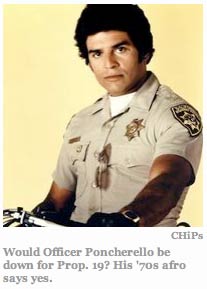![]() Nicholas D. Kristof in the New York Times: End the War on Pot
Nicholas D. Kristof in the New York Times: End the War on Pot
Our nearly century-long experiment in banning marijuana has failed as abysmally as Prohibition did, and California may now be pioneering a saner approach. Sure, there are risks if California legalizes pot. But our present drug policy has three catastrophic consequences.
First, it squanders billions of dollars that might be better used for education. […]
The second big problem with the drug war is that it has exacerbated poverty and devastated the family structure of African-Americans. Partly that’s because drug laws are enforced inequitably. Black and Latino men are much more likely than whites to be stopped and searched and, when drugs are found, prosecuted. […]
The third problem with our drug policy is that it creates crime and empowers gangs. “The only groups that benefit from continuing to keep marijuana illegal are the violent gangs and cartels that control its distribution and reap immense profits from it through the black market,†a group of current and former police officers, judges and prosecutors wrote last month in an open letter to voters in California. […]
One advantage of our federal system is that when we have a failed policy, we can grope for improvements by experimenting at the state level. I hope California will lead the way on Tuesday by legalizing marijuana.
![]() Financial Times Editorial (free registration required): High time to legalise marijuana
Financial Times Editorial (free registration required): High time to legalise marijuana
Just say no, the slogan says. But on November 2, California has the chance to say yes, at least to marijuana. Proposition 19 would legalise the production, sale and use of cannabis, abolishing an ineffective and socially damaging prohibition on a substance with fewer health risks than alcohol and tobacco. The Golden State should vote to legalise dope. […]
However California votes, marijuana will remain illegal in the US. Nor will Proposition 19 weed out all the social problems caused by narcotics use. But it will make a start at removing a failed policy that exacerbates these ills – an approach which could, if successful, perhaps in time be applied to other drugs. It is time to say yes.
This is an open thread.


